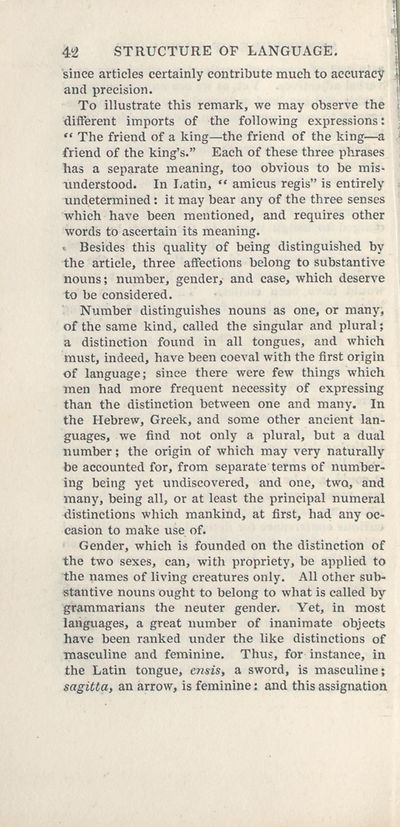Education > Essays on rhetoric
(70)
Download files
Complete book:
Individual page:
Thumbnail gallery: Grid view | List view

42 STRUCTURE OF LANGUAGE.
since articles certainly contribute much to accuracy i
and precision.
To illustrate this remark, we may observe the
different imports of the following expressions:
“ The friend of a king—the friend of the king—a
friend of the king’s.” Each of these three phrases
has a separate meaning, too obvious to be mis¬
understood. In Latin, '* amicus regis” is entirely
undetermined: it may bear any of the three senses
which have been mentioned, and requires other
words to ascertain its meaning.
Besides this quality of being distinguished by
the article, three affections belong to substantive
nouns; number, gender, and case, which deserve
to be considered.
Number distinguishes nouns as one, or many,
of the same kind, called the singular and plural;
a distinction found in all tongues, and which
must, indeed, have been coeval with the first origin
of language; since there were few things which
men had more frequent necessity of expressing
than the distinction between one and many. In
the Hebrew, Greek, and some other ancient lan¬
guages, we find not only a plural, but a dual
number; the origin of which may very naturally
be accounted for, from separate terms of number¬
ing being yet undiscovered, and one, two, and
many, being all, or at least the principal numeral
distinctions which mankind, at first, had any oc¬
casion to make use of.
Gender, which is founded on the distinction of
the two sexes, can, with propriety, be applied to
the names of living creatures only. All other sub¬
stantive nouns ought to belong to what is called by
grammarians the neuter gender. Yet, in most
languages, a great number of inanimate objects
have been ranked under the like distinctions of
masculine and feminine. Thus, for instance, in
the Latin tongue, crisis, a sword, is masculine;
sagitta, an arrow, is feminine: and this assignation
since articles certainly contribute much to accuracy i
and precision.
To illustrate this remark, we may observe the
different imports of the following expressions:
“ The friend of a king—the friend of the king—a
friend of the king’s.” Each of these three phrases
has a separate meaning, too obvious to be mis¬
understood. In Latin, '* amicus regis” is entirely
undetermined: it may bear any of the three senses
which have been mentioned, and requires other
words to ascertain its meaning.
Besides this quality of being distinguished by
the article, three affections belong to substantive
nouns; number, gender, and case, which deserve
to be considered.
Number distinguishes nouns as one, or many,
of the same kind, called the singular and plural;
a distinction found in all tongues, and which
must, indeed, have been coeval with the first origin
of language; since there were few things which
men had more frequent necessity of expressing
than the distinction between one and many. In
the Hebrew, Greek, and some other ancient lan¬
guages, we find not only a plural, but a dual
number; the origin of which may very naturally
be accounted for, from separate terms of number¬
ing being yet undiscovered, and one, two, and
many, being all, or at least the principal numeral
distinctions which mankind, at first, had any oc¬
casion to make use of.
Gender, which is founded on the distinction of
the two sexes, can, with propriety, be applied to
the names of living creatures only. All other sub¬
stantive nouns ought to belong to what is called by
grammarians the neuter gender. Yet, in most
languages, a great number of inanimate objects
have been ranked under the like distinctions of
masculine and feminine. Thus, for instance, in
the Latin tongue, crisis, a sword, is masculine;
sagitta, an arrow, is feminine: and this assignation
Set display mode to:
![]() Universal Viewer |
Universal Viewer | ![]() Mirador |
Large image | Transcription
Mirador |
Large image | Transcription
| Antiquarian books of Scotland > Education > Essays on rhetoric > (70) |
|---|
| Permanent URL | https://digital.nls.uk/113760332 |
|---|
| Description | Thousands of printed books from the Antiquarian Books of Scotland collection which dates from 1641 to the 1980s. The collection consists of 14,800 books which were published in Scotland or have a Scottish connection, e.g. through the author, printer or owner. Subjects covered include sport, education, diseases, adventure, occupations, Jacobites, politics and religion. Among the 29 languages represented are English, Gaelic, Italian, French, Russian and Swedish. |
|---|

